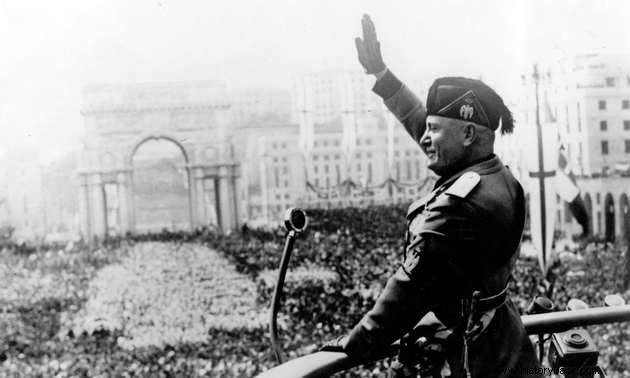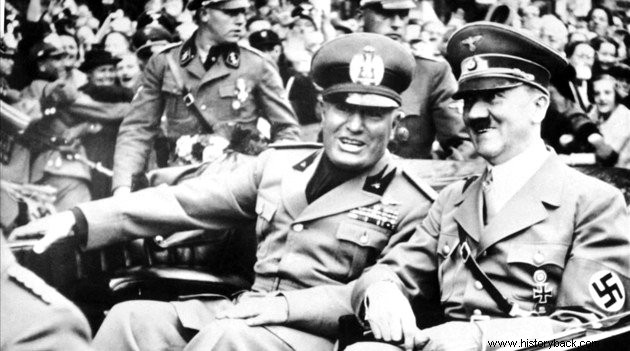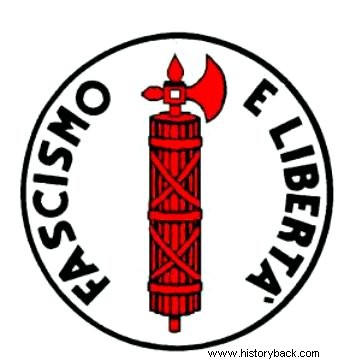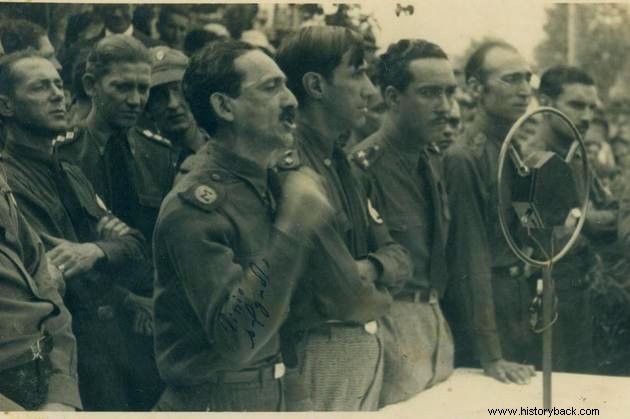The Fascism was a nationalist, anti-liberal and anti-socialist political system that emerged in Italy in 1919, at the end of the First World War, and lasted until 1943.
Led by Benito Mussolini, it influenced political regimes in several European countries, such as Germany and Spain in the interwar period.
It also inspired right-wing political movements in Brazil, such as Integralism.
Meaning of Fascism
The word fascism comes from the Latin fascio (beam), as one of the fascist symbols was the fascio littorio . This consisted of an ax wrapped in a bundle of sticks used in the ceremonies of the Roman Empire as a symbol of union.
After the damage caused by this ideology in World War II, the word fascism gained new meanings. Now, in the first decades of the 21st century, it is common to call "fascism" or "fascist" the individual or movement that defends violent repression to solve society's problems.
However, this definition has nothing to do with what fascism was like in Italy in the 1920s and 1930s. For fascists, violence was a means to power, not an end.
Although they used violent methods in demonstrations, they were no different from other political groups at the time.
Characteristics of Fascism
Fascism was characterized by being a political system opposed to socialism and also imperialist, anti-bourgeois, authoritarian, anti-liberal and nationalist.

- Totalitarian State :the state controlled all manifestations of individual and national life.
- Authoritarianism :the leader's authority was indisputable, as he would be the most prepared and knew exactly what the population needed.
- Nationalism :the nation is a supreme good, and in its name any sacrifice should be demanded and made by individuals.
- Anti-liberalism :fascism agreed with some capitalist ideas, such as private property and the free enterprise of small and medium-sized enterprises. On the other hand, he defended state intervention in the economy, protectionism and, in the case of some fascist currents, the nationalization of large companies.
- Expansionism :expanding borders was seen as a basic need, as it was necessary to conquer “living space” for the nation to develop.
- Militaryism :national salvation would come through military organization, struggle, war and expansionism.
- Anti-Communism :the fascists rejected the idea of the abolition of property, of absolute social equality, of the class struggle.
- Corporativism :Instead of advocating the concept of "one man, one vote", the fascists believed that professional corporations should elect political representatives. They also maintained that only cooperation between classes guaranteed the stability of society.
- Society hierarchy :fascism valued a vision of the world according to which it is up to the strongest, in the name of the "national will", to lead the people to security and prosperity.
Fascism promised to restore war-torn societies by promising wealth, a strong Nation and no political parties that harbored antagonistic views.
See also:Differences between Communism and SocialismFascism in Italy
A deep sense of frustration dominated Italy after the First World War (1914-1918). The country left disappointed for not having its demands met in the Treaty of Versailles and the economic situation was more difficult than before the war.
Thus, the social crisis gained revolutionary aspects with the growth of the left and right-wing movements.
In March 1919, in Milan, journalist Benito Mussolini created the "Fasci di Combatimento " and the "Squadri " (combat groups and squadron respectively). These were intended to fight political opponents, especially communists, by violent means.
The National Fascist Party, officially founded in November 1921, grew rapidly:the number of members rose from 200,000 in 1919 to 300,000 in 1921. -fighters and unemployed.
In 1919, a million workers went on strike; the following year, they totaled 2 million. More than 600,000 metalworkers from the north occupied factories and tried to run them according to socialist ideas.
For its part, the parliamentary government, made up of the socialist party and the popular party, did not reach an agreement on major political issues. This would make it easier for the fascists to come to power.
March on Rome
In October 1922, during the Fascist party congress held in Naples, Mussolini announced the "March on Rome", in which fifty thousand black shirts - the Fascist uniform - went to the Italian capital. Powerless, King Victor Emanuel III invited the leader of the fascists, Benito Mussolini, to form the Ministry.
In the rigged elections of 1924, the fascists won 65% of the votes, and in 1925 Mussolini becomes the Duce ("leader", in Italian).
Mussolini began to implement his program:he ended individual liberties, closed and censored newspapers, annulled the power of the Senate and the Chamber of Deputies, created a political police, responsible for repression, etc.
Gradually, the dictatorial regime was installed. The government maintained the appearance of a parliamentary monarchy, but Mussolini held full powers.
After granting himself great political authority and surrounding himself with the ruling elites, Mussolini sought the economic development of the country. However, this period of growth was severely affected by the crisis of 1929.
See also:March on RomeTotalitarianism and Fascism
Totalitarianism represents an authoritarian and repressive political system, in which the State controls all citizens, who do not have freedom of expression or political participation.
The interwar period was a time of political radicalization. This is how totalitarian regimes were installed in several European countries, such as Italy, from 1922, and Nazism, in Germany, in 1933.
The expansion of totalitarian regimes was related to the economic and social problems that Europe went through after the First World War. There was also the fear that socialism, implanted in Russia, would expand.
For many countries, a totalitarian dictatorship seemed like a solution, as it promised a strong, prosperous reaction without social unrest. In addition to Italy and Germany, countries such as Poland and Yugoslavia were dominated by totalitarian regimes.
Fascism also inspired authoritarian regimes such as "Franquismo" in Spain and "Salazarismo" in Portugal.
See also:Main Features of TotalitarianismFascism and Nazism

It is very common to have confusion between the terms “fascism” and “nazism”. After all, both are totalitarian and nationalist political regimes that developed in Europe in the 20th century.
However, fascism was implemented in Italy by Benito Mussolini during the interwar period. Nazism was a fascist-inspired movement that took place in Germany, led by Adolf Hitler and based mainly on anti-Semitism.
Symbols of Fascism

In Italy, the symbols of fascism were:
- Fascio :the symbol that gave rise to the word appeared on several monuments, seals and official documents.
- Black Shirt :it was part of the uniform of the fascists and, therefore, its members were called "black shirts".
- Greetings :with the right arm raised.
- Motto :"Believe, Obey, Fight" was said in political speeches and was present in medals, paintings, etc.
Fascism in Brazil

Fascism in Brazil was represented by Plínio Salgado (1895-1975), founder of the Brazilian Integralist Action, in 1932. Salgado adopted a motto in Tupi-Guarani "Anauê ", the Greek letter "sigma" as a symbol and dressed his supporters in green shirts.
He defended a strong State, but publicly rejected racism, as this doctrine was incompatible with Brazilian reality. Anti-communist, he approached and supported Getúlio Vargas until the 1937 coup, when the AIB was closed, as were the other Brazilian parties.
In this way, some integralist militants promoted the Integralist Levante of 1938, but it was quickly suppressed by the police. Plínio Salgado was exiled to Portugal and many of his companions were imprisoned.
The Estado Novo and Fascism
The government of Getúlio Vargas during the Estado Novo (1937-1945) had fascist characteristics such as censorship, one-partyism, the existence of a political police and the persecution of communists.
However, it was not expansionist and did not choose any other people to be the target of attacks. Thus, we can say that the Estado Novo was nationalist and not fascist.
See also :
- Salazarism in Portugal
- Anarchism
